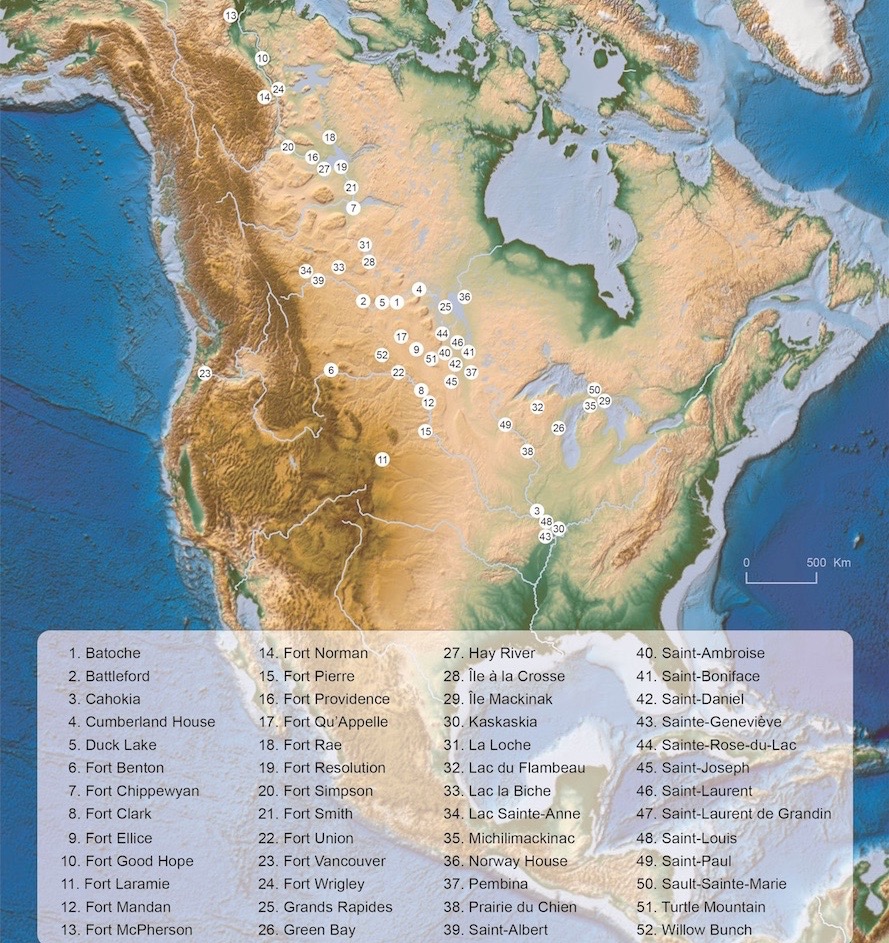The Métis National Council (MNC), a national political organization, states that the 'Historic Métis Nation Homeland' is the area of land in west central North America used and occupied as the 'traditional territory' of the Métis, however they did not lay down boundaries of this territory.(1) Today's current boundaries of this area include the 3 prairie provinces, parts of Ontario, BC, Northwest Territories and the northern plains of the United States.
Métis communities, culturally distinct from both their First Nation and European relations, began to form around the Great Lakes regions as European men working for fur trade companies started families with First Nations women. As the fur trade moved west, so did the French-Canadian fur traders. Métis communities were established along the major fur trade routes, mostly near the important freighting waterways. Métis settlements were located as far west as British Columbia and as far north as the Mackenzie River in the Northwest Territories.(2)
The following map, from the Canadian Encyclopedia website, shows the location of the more well known Métis communities.(3)

1810-1869: Birth of a Nation
By 1810 the Métis had established themselves as suppliers of bison/pemmican to the fur trade in what was then known as Rupert's Land. In the Red River area of present day Manitoba, Scottish settlers under Thomas Douglas, Earl of Selkirk, arrived in 1811 to establish an agricultural community. The Métis in the area felt threatened by the influx of settlers, feeling it would have a negative impact on their livelihood as suppliers to the fur trade as Selkirk established restrictions on their hunting and trading practices. Selkirk attempted to evict the Métis, and the Métis under the leadership of Cuthbert Grant prepared to defend their territory. The Battle of Seven Oaks in 1816 was the first armed conflict that involved the Métis regarding land. The Métis won that battle and their identity as a nation and a political entity was fortified by the win.(2)
Self-identity continued to blossom after the 1821 North West Company-HBC amalgamation. There was an influx of Métis families to the Red River settlement. Scottish Métis joined French Métis in defending common interests against the governing Hudson Bay Company authorities and their fur trade monopoly during the 1830s to 1840s. Métis hunting parties also fought with Dakota hunting parties for access to the rich bison-hunting grounds of present day North and South Dakota throughout the 1850s until a treaty was signed in 1862.(4)
1869-1870: Red River Resistance
In 1867, the British North America (BNA) Act is passed, creating Canada and in 1869, an agreement is reached for the Hudson's Bay Company (HBC) to transfer Rupert's Land to the Dominion of Canada. The Métis and other First Nations questioned how the land that they inhabited had come under the ownership of the HBC when there had never been any agreements made with the original inhabitants. Métis leaders began strategizing resistance efforts at public meetings in 1869. The armed conflict that ensued is now known as the Red River Resistance.
The Red River Colony, led by Louis Riel, resists the ferderal government's land surveying activity as the government prepares for expansion into the West without consultation of the Métis and First Nations Peoples who already live in and around the area we now call Winnipeg, Manitoba. When the resistance ends, Louis Riel is forced into exile into the United States.
The following video presents the life of Louis Riel and the Métis resistance at Red River and Batoche.
1870: Manitoba Act
The Manitoba Act brings the Red River colony into Confederation as the province of Manitoba and marks the legislative resolution of the conflict between the federal government and the Red River Colony, known as the Red River Resistence. The Act met the demands of the Métis, and included the following:
- bilingual denominational schools,
- judicial and parliamentary systems, and
- the extinquishment of their 'Indian' title to the land, through the granting of 1.4 million acres of land to Métis
You can read the full Manitoba Act, online, here.
For those Métis living in what is now Saskatchewan, the Dominion Lands Act of 1879 (Section 125) also included provisions to extinquish the Métis' Indian title through the scrip system. Scrip Commissioners gave the Métis land or money scrip in exchange for their Indian title. The scrip system was fraudulent and most Métis did not receive or hold title to any land.
< Chapter 9 Table of Contents Chapter 11 >
(1). Métis National Council. (n.d.) Métis Nation Citizenship. Retrieved from: http://www.metisnation.ca/index.php/who-are-the-metis/citizenship
(2). Gaudry, A. (2009). Métis. Retrieved from: http://www.thecanadianencyclopedia.ca/en/article/metis/
(3). Gagnon, D. (2016). The Other Métis. Retrieved from: http://www.thecanadianencyclopedia.ca/en/article/the-other-metis/
(4). Barkwell, L. (n.d.) Métis Firsts in North America. Retrieved from:http://www.mmf.mb.ca/metis_firsts_in_north_america.php